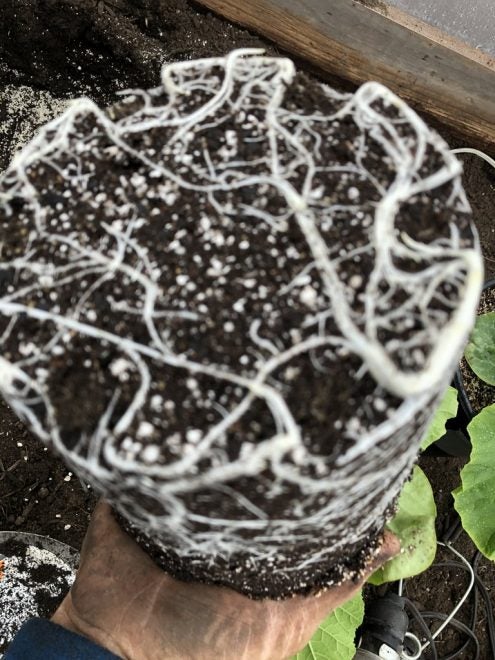Home On The Range #13: Back to the Roots with Mycorrhizae
RusDs 01.15.21

Welcome back to our recurring series of “Home on the Range.” Here, we would like to share all of our experiences for those who may be homesteading, living off the land, hunting, farming, ranching, and truly investing in nature and the great outdoors. The ability to provide for yourself and your family can be tremendously rewarding and simultaneously difficult at times. So, in “Home on the Range” we want to share our different exploits so you can learn and hopefully we can receive your feedback along the way as well.
Rev up your roots with Mycorrhizae
Now you see why I didn’t title this “Open your eye to Mycorrhizae.” Impossible for me to spell from memory and hard for me to say, Mycorrhizae (I’ll refer to it as “Myco”, from now on) are the little fungi that have a symbiotic (yet sometimes parasitic) relationship with the roots and rootlets of your plants. The word mycorrhizae is the combination of the greek words for “fungus” and “root.”
While “root fungus” might sound like a bad thing on the surface, these fungi are very, very beneficial to the root systems of plants. In exchange for feeding upon the sugars created by the plants, they are essential for transporting minerals and water to the roots from the soil. The most prevalent Mycos in agriculture are known as Arbuscular Mycorrhizae, more commonly referred to by their umbrella term endomycorrhizae. These can penetrate the cell wall of the roots and provide for this important nutrient exchange. Ectomycorrhizae are only used in tree farming, and are largely a different subject.
But what does all this agricultural science mean in real life terms? Endo Myco aids plants in a number of ways. They can increase flowering and fruiting, root growth, and the rate of photosynthesis. This results in faster, more robust growth and better yields.
Furthermore, the increased nutrient and water uptake from the soil renders one’s plants more drought and stress resistant. If you use fertilizer in your operations, the utilization of myco when seeding can reduce the amount of fertilizer necessary. If you have a lot of indoor starts that need to be transplanted later to your planter beds, the use of myco both when seeding and when transplanting greatly aids in transplantation success. Its like putting a support network in for your plants.
Hard to Say, Easy to use
Mycos can be had in a mix with other soil additives (such items can be found at most ACE hardware stores), or as a standalone “inoculant”. Though largely safe to use, they can be harmful if swallowed right out of the bag, as they are, technically speaking, microbes and will imbalance your gut biome.
Application is pretty simple. For speed starts, use 6oz of Myco for every 1.5 cubic feet of starting soil. For average vegetable gardening use, 5 – 10 Lbs per acre, and for field crops you can apply the same amount via seed drill. When transplanting starts, sprinkle approximately 1-2 tablespoons where you are going to re-plant the start.
The same benefits your produce and crops can glean from myco also can apply to your lawn. Fertilizer reduction, water use reduction, heat and drought resistance, enhanced color and improved texture are all the results I’ve seen in my own lawn after seeding with an application of myco. Its one way to actually get your grass greener! A thick base of myco in the root system of your grass also aids in weed exclusion. Myco has also been known to aid in the growth of record breaking giant produce, such as giant pumpkins.
Prices for mycorrhizae inoculant range from $8 – $40 per Lbs, so choose wisely. My advice is to steer clear of certain overpriced mycos that come in packaging clearly aimed at the “indoor growing” community, and hedge more towards those aimed at small farms and organic gardening. There’s an extremely wide range of endo myco to choose from, some aimed more at lawn seeding, and some aimed at produce cultivation. I’ve used the produce-geared myco on my lawn, however, and had excellent results.
Underneath it All
Understanding the what, why, and how of mycos has aided me in better yields and healthier plants of all kinds. From simply understanding what the white fungus is underneath my lawn, to realizing excellent crop and produce yields, my utilization of mycorrhizae is just another piece of the interesting puzzle of how to grow and maintain bigger, better, and healthier plants. I know mycorrhizae are a rather dry subject, but the understanding and application of myco will greatly aid you in your quest for better produce and crop yields.
For everyone in our reading audience, have you ever used mycorrhizae before? Are there any other tips or tricks you use to make your plants grow better or your grass more green? As always, let us know all of your thoughts in the Comments below! We always appreciate your feedback, and thanks again for reading, until next time!